Premium Wear Resistant Lining Elbow
Ceramic patch lined pipe for power plant is composed of three layers: outer steel pipe layer, corundum layer, and ceramic glue layer.
The inner ceramic layer is white from the surface. The ceramic is generally 95% ceramic, and the temperature is generally below 200°C. The Ceramic tile lined pipe spool is composed by steel pipe, adhensive and abrasion-resistant ceramic, we use 20 # seamless steel pipes shaping with hot bending (it is different from centrifugal casting or steel plate rolling), the ceramic tiles bonding with GWJ-350 high temperature-resistant inorganic adhesive which was developed by TsingHua University and affix abrasion-resistant ceramic in the steel pipes, we use miss match installation instead of directly bonding (this technology was used in the bridge building a thousand years ago), and forms a firm wear-resistance layer after heating solidification. Ceramic tile lined pipe spool is applicable for the pneumatic powder-feeding, and can be used under a temperature of 350℃without aging and peeling for long life. The service life is 4-5 times than the normal abrasion-resistant pipes.
Advantage
- Super wear-resistant, high density: we use 95% of chromium corundum, 100 tons dry-pressing.
- Elbows formed by hot-bending, the outside of the bending part are seamless which is wear-resistant and can prolong the service life.
Firmly bonding without pealing: we use epoxy adhesive and miss-match installation technology, so that there is no straight-seam. - High temperature and ageing resistance: we abandon the traditional organic bond, and use inorganic bond which is ageing resistance.
High pressure resistance: We use 20# seamless steel pipe, which is high pressure resistance and avoiding welding leakage. - The pipe with smooth inner wall which can make the materials flow smoothly: we use seamless steel pipes which has smooth inner wall that can reduce weariness, and the height tolerance of ceramics is below 0.5mm.
Application Guidance
- Avoid welding on site, the welding layer should be 30mm above the ceramic layers; according to our experiences, if you need a shot welding (for example spot welding) or must welding, watering after welding, which will reduce the damage of adhesive layer.
- Avoid striking and throwing the pipes during transportation and installation.
- To achieve the best abrasion-resistant solutions, thicken ceramic liners can be used in the elbow which has serious abrasions.
Physical properties of ceramic tile lined pipe
| Flexure strength | Tensile strength | Elongation | Cross section stretch Ratio | Impact toughness | Hardness of wearable layer | Hydrostatic testing pressure |
| MN/㎡ | MN/㎡ | % | % | J/c㎡ | HRC | Mpa |
| >610 | >700 | 5 | 5.1 | >15 | >38 | 5.6-12.9 |
To achieve the best abrasion-resistant solutions, thicken ceramic liners can be used in the elbow which has serious abrasions.
Characteristics And Production Technology Of Ceramic Tile Lined Pipe
Ceramic tile lined pipe using ceramic-metal composite production technology principle, with Al2O3 as raw material.
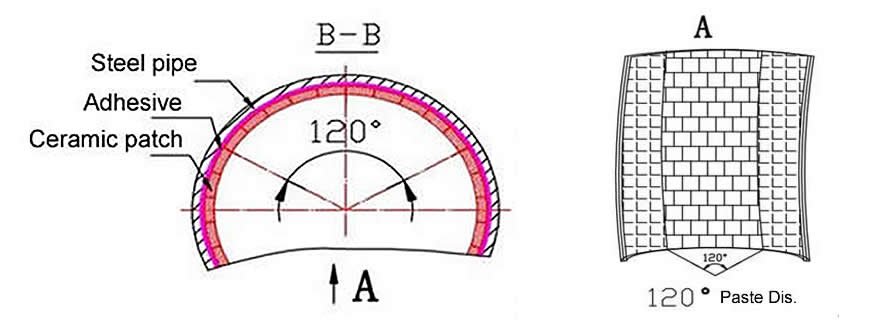
Ceramic tile lined pipe process welding sturcture
Special Corundum ceramics made of rare metal oxides as solvents and sintered at high temperature by 1730 ℃ through bonding, welding, mosaic, riveting and socket technology, a variety of wear-resistant ceramic pieces, block brick materials in the pipe wear surface, so as to form a surface with excellent wear resistance, and the matrix is still using the composite pipe of ordinary metal.
According to different needs of the choice of wear-resistant ceramic patches, to meet the special needs of users of technical conditions. Compared with the traditional all-metal high alloy pipe fittings, the working face has higher abrasion resistance, which can make the whole wear-resistant and anticorrosion service life of the pipe increase several times to dozens of times times. Overall weight of the first mate down, reduce the amount of steel, reduce the cost of equipment and maintenance costs, improve economic efficiency.
Alumina Ceramic – Abrasion Resistant Linings
Alumina is a cost effective and widely used material in the family of engineered ceramics. Alumina ceramics have been developed and optimized for maximum wear resistance and corrosion resistance. A high density, diamond like hardness, fine grain structured and superior mechanical strength are the unique properties that make it the material of choice for a wide range of demanding applications.
Alumina Ceramic has uses similar to cast basalt but it has greater resistance to wear in high velocity applications and impact resistance in extreme dynamic systems.
Sunny Steel provides its customers with the full range of abrasion resistant lined pipe work including straight pipe, bends and elbows, reducers, tees and y-pieces. Sunny Steel offers a comprehensive range of lining materials designed to combat erosion.
Basalt and alumina ceramic are the two generally accepted lining materials. Other linings which complement the basalt and ceramic include Eucor, AZS, silicon nitride bonded silicon carbide, and ceramic filled epoxy coatings.
Main properties of ceramic tile lined pipe
Ceramic tile lined pipe wear good: wear-resistant ceramic pipe lining ceramic layer for wear-resistant engineering ceramics, its hardness (HRA) ≥84, its wear resistance is high chromium wear-resistant cast iron alloy pipe fittings more than 10 times times. The use of 5mm thick ceramic layer, its actual wear-resistant life will be equivalent to 50mm thick wear-resistant cast steel.
Ceramic patch Composite pipe corrosion resistance: the use of different wear-resistant ceramic materials, for different corrosive medium has excellent anti-corrosion properties, acid, alkali, salt and other strong corrosive medium and brine corrosion characteristics.
Ceramic tile lined pipe high temperature performance: wear-resistant ceramic itself with 1200 degrees Celsius above the high-temperature capacity, through reasonable design and use of different composite methods, wear-resistant ceramic pipe fittings can be in-50 ℃ to 800 ℃ humidity range of long-term operation, especially for high-temperature burners and other equipment lining.
Ceramic tile lined pipe to reduce project cost: wear-resistant ceramic pipe is mainly used for conveying particles of liquid-solid two-phase flow and corrosive media, for the replacement of expensive stainless steel tubes, high chromium cast steel pipe, carbide wear-resistant pipe, can directly reduce the project cost, while prolonging the service life. Products cost-effective, can save maintenance, replacement material costs and time.
Ceramic Patch Composite pipe is our company to draw on the domestic and foreign advanced technology of similar products developed on the basis of a shell for steel, wear-resistant ceramic tube of new composite pipe products, with high wear resistance, long service life and so on.
Characteristics of ceramic tile lined pipe
The use of anti-fall porcelain tube, porcelain pipe inlay, so that the paste more flat, more solid.
The use of strong inorganic adhesive paste, wear-resistant steel bowl welding, porcelain tube and steel combined to form a double reinforcement to ensure that the porcelain tube does not fall off.
The surface of the porcelain tube is smooth, the running resistance is small, the scaling is unfavorable.
Flexible installation, high abrasion resistance, convenient processing and moderate cost.
Production process of ceramic tile lined pipe
Steel body Grinding-> Ceramic patch-> Paste-> Welding-> Detection
- Use tools to clean the surface of the steel body.
- The raw material can be mixed evenly before use.
- The ceramic tube is pasted by professionals to ensure that the porcelain tube is free from the wrong side and the surface of the ceramic pipe is smooth.
- After testing qualified storage.
What is the temperature of the wear-resistant tube with ceramic patch technology? How about the paste strength?
As a result of the use of paste technology, the main use of high-temperature, high-strength adhesives for pasting ceramic patches, and most of the use of high polymer adhesive temperature is not higher than 200 degrees, and the higher the temperature, adhesive strength is lower, aging speed also increased rapidly.
Therefore, the use of paste ceramic technology, the workpiece temperature is generally not higher than 150 ℃, under this temperature, the general ceramic and metal paste strength can reach 200 kg/cm. For higher than this temperature components, can be used ceramic composite wear-resistant process treatment, so that the use of temperature can reach 500 or more than 700 degrees.
The specifications for ceramic tile lined chips
There are many clients who are concerned about the specification of ceramic lined tile sheet, because it is related to whether the ceramic chip purchased can be used.
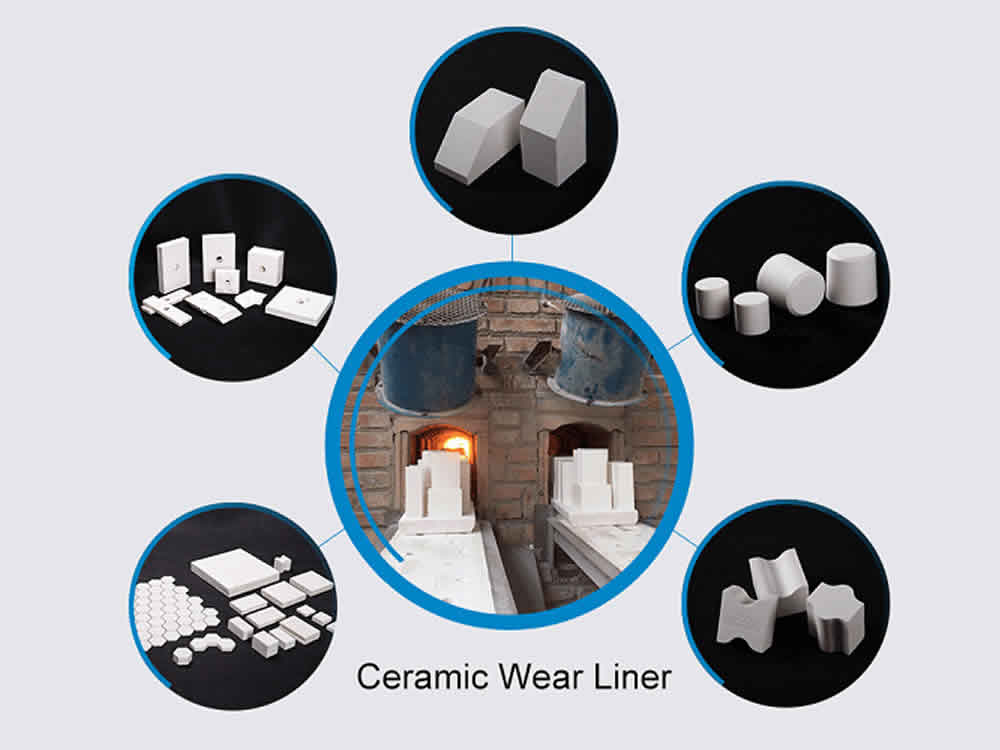
Wear resistant ceramic lining is AL203 as the main material, with rare metal oxide as solvent, after more than 1700℃ high temperature roasting to special ceramic, embedded into rubber , polyurethane or mild steel for the purpose of low to moderate impact and highly abrasive sliding application.
Anti-corrosion service life.
Main performance indicators: The wear resistance of the ceramic work surface is more than 100 times that of manganese steel, 20 times that of high chromium cast iron, and several times to several dozen times higher than that of wear resistant rubber. Ceramic metal bonding strength up to 300kg/cm2 can be used up to 500°C.
The use of equipment made of wear-resistant ceramics, the service life can be increased by more than five times, and the performance-cost ratio can be increased by more than three times.
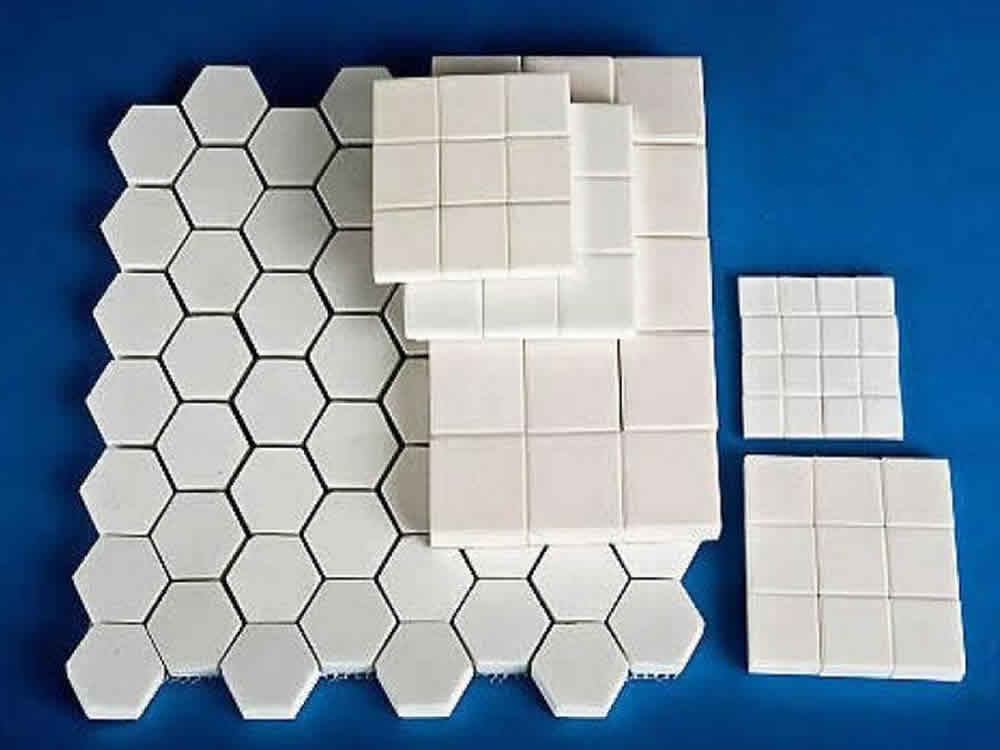
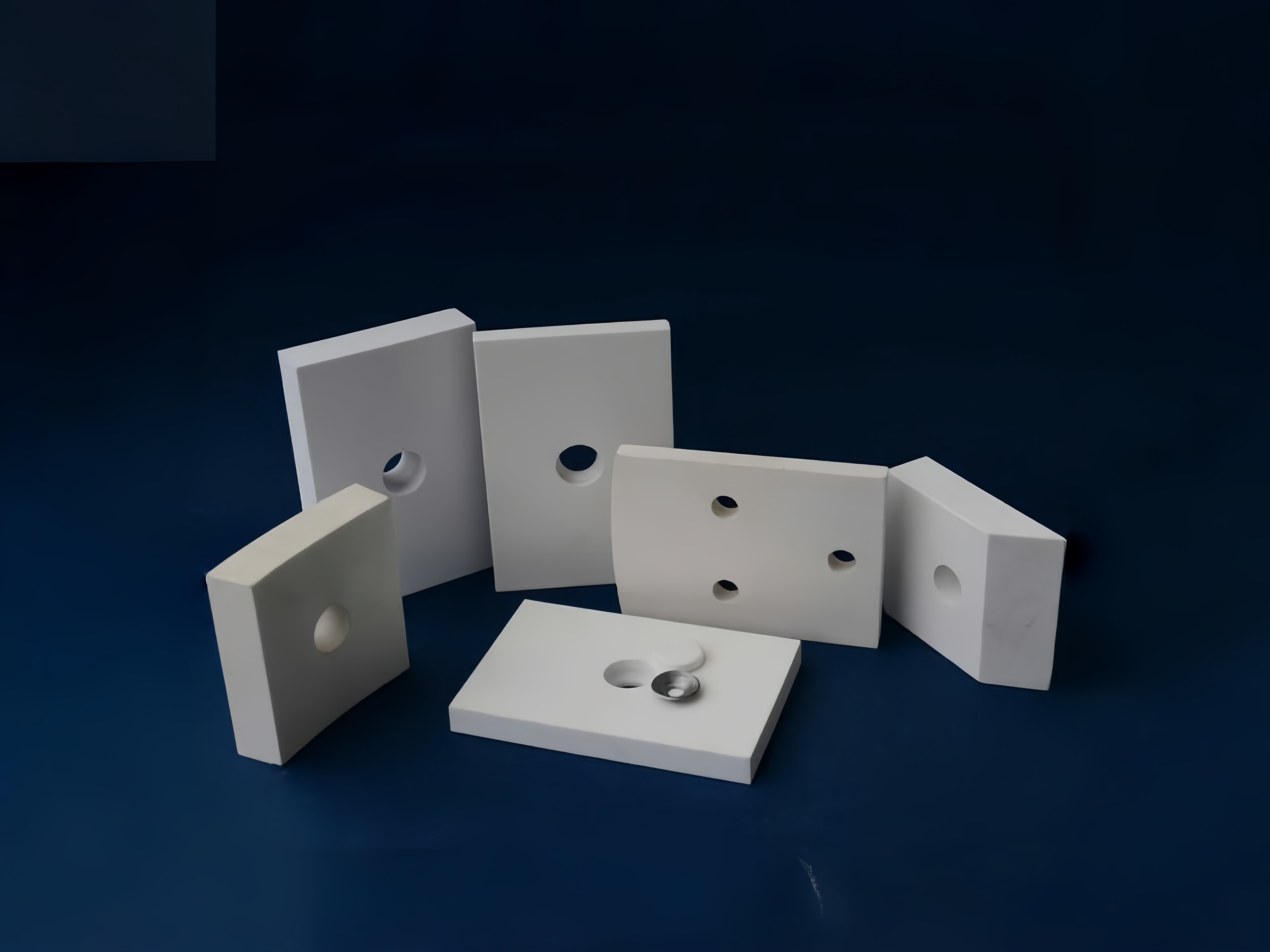
Wear-resistant ceramic performance characteristics
- Hardness, general hardness is greater than HRA80, the highest can reach 92 or more.
- Excellent wear resistance: at least 200 of ordinary carbon steel and 10 times more than high chromium cast iron.
- Light weight: The specific gravity of alumina is generally only about 3.6, silicon carbide is about 2.7, and zirconia is about 6.
- Good heat resistance: The heat resistance of different wear-resistant ceramics is not the same, but it is used for particle-resistant scouring, and there is no problem in heat resistance.
Why Ceramic Coating?
The abrasion pipe of thermal power plant is mainly conveying raw coal powder, ash slag, flue gas desulfurization (FGD) limestone powder and slurry, due to the transmission of medium velocity fast, poor operating conditions, resulting in pipelines, especially elbow, variable diameter pipe serious wear and corrosion, not only consumes a lot of metal materials, but also to the thermal power plant security, economic operation has brought hidden dangers. The abrasion mechanism of pipeline is mainly based on erosion wear. Wear-resistant pipe can be divided into two categories: single metal pipe and composite pipe.
Remarks
- Ceramic coating is used by the OE’s extensively on 2007 & newer exhaust.
- Ceramic coating is recommended for parts that are exposed to extreme heat.
- Ceramic coating is used inside of chrome stacks to reduce the outside temperature of the pipe.
- Ceramic coating will increase the longevity of the chrome stack.
- Ceramic coating produces more usable power.
- Ceramic coating protects parts from thermal fatigue.
Features
Ceramic tile lined pipe is our company to absorb similar products at home and abroad on the basis of advanced technology developed a shell for the steel body, within the wear-resistant ceramic tube of the new composite pipe products, with high wear resistance long service life and so on

The use of anti-off porcelain tube, porcelain tube mosaic, so that paste more flat, more solid with a strong inorganic adhesive paste, wear-resistant steel bowl welding, porcelain and steel body combined to form a double reinforcement to ensure that the porcelain tube does not fall off. The installation of flexible, high wear resistance, processing convenience, the cost is moderate.
High hardness
Rockwell hardness of high alumina ceramics is up to HRA80-90 which is second only to diamond and far exceeds wear-resistant steel stainless
Excellent wear resistance
The wear resistance of high alumina ceramics is 266 times that of manganese steel and 171.5 times that of high chromium cast iron. According to our investigation & follow-up to the clients, the service life of equipment can be prolonged over 10 times under the same working conditions.
Corrosion resistance
High alumina ceramics are inorganic oxides with extremely stable molecular structure and no electrochemical corrosion, thus they can resist erosion of acid, alkali, salt solutions and organic Solvents.
Thermostability
Working temperature of high alumina ceramics can be as high as 1400℃.
Good self-lubricity
High alumina ceramics have the properties of self-lubricity and in adhesion, the roughness is only 1/6 that of steel pipes thus less flow Resistance.
Light weight
The density of high alumina ceramics is about 3.6g/cm3, which is only half that of steel, thus easy for construction and installation.
Technology and structure of ceramic tile lined pipe
Ceramic tile lined pipe is composed of three layers: outer steel pipe layer, corundum layer, and ceramic glue layer. The inner ceramic layer is white from the surface. The ceramic is generally 95% ceramic, and the temperature is generally below 200°C.
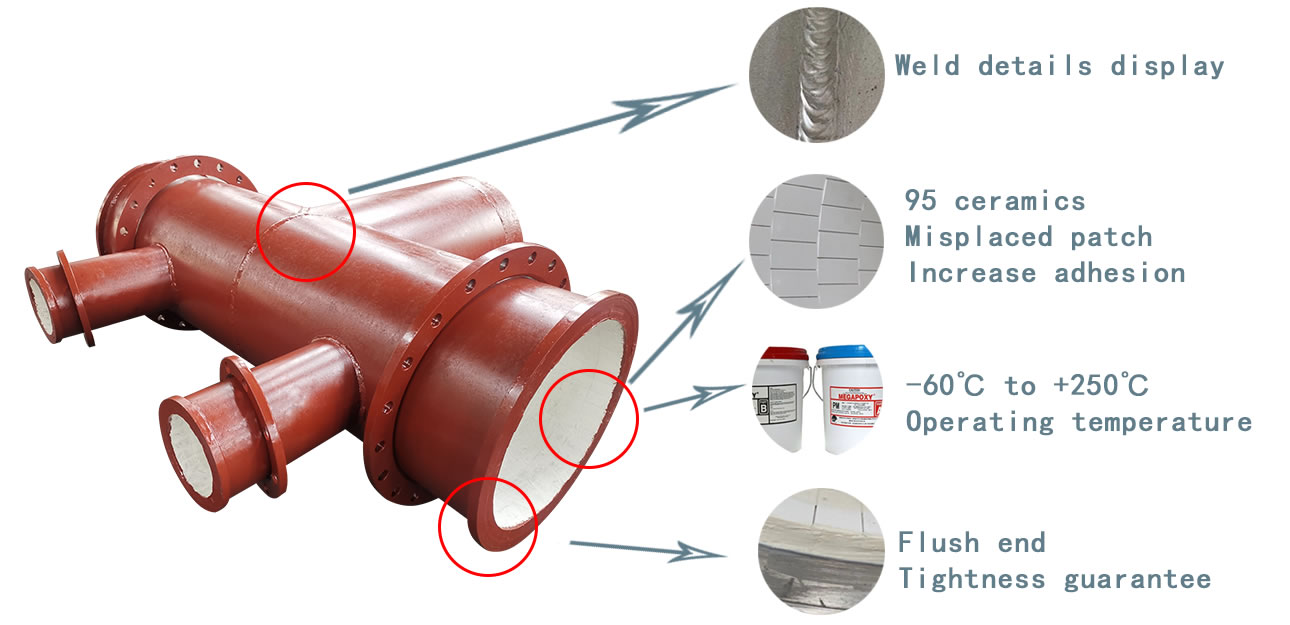
At present, the common ceramic sheets lined with ceramic composite pipes are: ceramic block, dovetail mutual pressure, welding type, mosaic, card slot and so on. It has the characteristics of wear resistance and long service life.
Performance
- Large hardness
Rockwell hardness HRV 80-90 - High wear resistance
Wear resistance is equivalent to 20-30 times of high manganese steel. - Light weight
Its density is 3.9g/cm³, which is only half that of steel, which can greatly reduce the equipment load - Imported glue
Magbao imported glue, bonding strength: 10Mpa, working temperature: -60℃ to +250℃, welding type, wear resistance up to 800℃.
Specifications
- Pipe diameter: ≥DN100
- Steel pipe thickness: ≥4mm
- Steel pipe material: Q235 or stainless steel
- Ceramic thickness: 4mm, 6mm, 8mm, 10mm, etc.
- Connection method: flange, welding, casing, V-connector
- Working pressure: ≤1.0 MPa (other pressures need to be communicated with customer service)
Ceramic tile technical indicators
- Ceramic marking: 92-95
- Bulk density: 3.9g/cm³
- Tensile strength: 1030MPa
- Flexural strength: 212MPa
- Hardness HRV: 80-90




